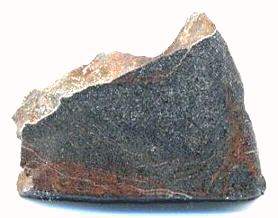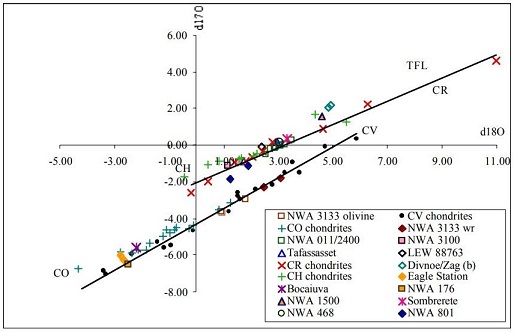CR6
(Primitive achondriteAchondrite with an almost chondritic composition with age similar to the primordial chondrites. These should be better classified as "metachondrites". in MetBull 89)

Purchased June 2003
no coordinates recorded
A single
meteoriteWork in progress. A solid natural object reaching a planet’s surface from interplanetary space. Solid portion of a meteoroid that survives its fall to Earth, or some other body. Meteorites are classified as stony meteorites, iron meteorites, and stony-iron meteorites. These groups are further divided according to their mineralogy and Click on Term to Read More weighing 136 g was purchased in Rissani, Morocco. The stone was analyzed at Northern Arizona University (T. Bunch and J. Wittke) and was initially thought to represent a very fine-grained, completely recrystallized L7
chondriteChondrites are the most common meteorites accounting for ~84% of falls. Chondrites are comprised mostly of Fe- and Mg-bearing silicate minerals (found in both chondrules and fine grained matrix), reduced Fe/Ni metal (found in various states like large blebs, small grains and/or even chondrule rims), and various refractory inclusions (such Click on Term to Read More (Bunch
et al., 2005). Two very small relict
chondrulesRoughly spherical aggregate of coarse crystals formed from the rapid cooling and solidification of a melt at ~1400 ° C. Large numbers of chondrules are found in all chondrites except for the CI group of carbonaceous chondrites. Chondrules are typically 0.5-2 mm in diameter and are usually composed of olivine Click on Term to Read More were identified in the thin sections studied. This meteorite has been shocked to stage S1 and terrestrially weathered to grade W2.
Despite its similarities to an L7 chondite, certain elemental ratios such as Fe/Mn and Ca/Na were inconsistent with those known from any
ordinary chondriteWork in Progress Ordinary chondrites (OCs) are the largest meteorite clan, comprising approximately 87% of the global collection and 78% of all falls (Meteoritical Society database 2018)1. Meteorites & the Early Solar System: page 581 section 6.1 OC of type 5 or 6 with an apparent shock stage of S1, Click on Term to Read More group, and therefore an O-isotopic analysis was conducted. Based on the values from the completed analysis, conducted at the University of Western Ontario (T. Larson and F. Longstaffe), it was demonstrated that the
O-isotope plot of NWA 3100 falls along the trend line of the CR
chondritesChondrites are the most common meteorites accounting for ~84% of falls. Chondrites are comprised mostly of Fe- and Mg-bearing silicate minerals (found in both chondrules and fine grained matrix), reduced Fe/Ni metal (found in various states like large blebs, small grains and/or even chondrule rims), and various refractory inclusions (such Click on Term to Read More. This suggests that NWA 3100 is likely genetically related to the CR
carbonaceous chondriteCarbonaceous chondrites represent the most primitive rock samples of our solar system. This rare (less than 5% of all meteorite falls) class of meteorites are a time capsule from the earliest days in the formation of our solar system. They are divided into the following compositional groups that, other than Click on Term to Read More group. Studies of the
REEOften abbreviated as “REE”, these 16 elements include (preceded by their atomic numbers): 21 scandium (Sc), 39 Yttrium (Y) and the 14 elements that comprise the lanthanides excluding 61 Promethium, an extremely rare and radioactive element. These elements show closely related geochemical behaviors associated with their filled 4f atomic orbital. Click on Term to Read More pattern for NWA 3100 also demonstrate a similarity to the CR-related, FeO-rich
achondriteAn achondrite is a type of stony meteorite whose precursor was of chondritic origin and experienced metamorphic and igneous processes. They have a planetary or differentiated asteroidal origin where the chondritic parent body reached a sufficient size that through heating due to radioactive decay of 26Al (aluminum isotope) and gravitational Click on Term to Read More LEW 88763 (Bunch
et al., 2008 and reference therein); however, new analyses of LEW 88763 by Day
et al. (2015) led them to propose its reclassification as an anomalous achondrite, with a possible relationship to the
ungroupedModifying term used to describe meteorites that are mineralogically and/or chemically unique and defy classification into the group or sub-group they most closely resemble. Some examples include Ungrouped Achondrite (achondrite-ung), Ungrouped Chondrite (chondrite-ung), Ungrouped Iron (iron-ung), and Ungrouped Carbonaceous (C-ung). Click on Term to Read More achondrite NWA 6704 pairing group.
A cooperative study was undertaken of a number of previously ungrouped achondrites, primitive achondrites, and silicated irons which have O-isotopic compositions that plot along the CR
oxygenElement that makes up 20.95 vol. % of the Earth's atmosphere at ground level, 89 wt. % of seawater and 46.6 wt. % (94 vol. %) of Earth's crust. It appears to be the third most abundant element in the universe (after H and He), but has an abundance only Click on Term to Read More isotopeOne of two or more atoms with the same atomic number (Z), but different mass (A). For example, hydrogen has three isotopes: 1H, 2H (deuterium), and 3H (tritium). Different isotopes of a given element have different numbers of neutrons in the nucleus. Click on Term to Read More trend line (Bunch
et al., 2005—Northern Arizona University, University of Washington, and University of Western Ontario). From the meteorites that were studied, including NWA 3100, NWA 801, Tafassasset, NWA 011 pairing group, LEW 88763, Sombrerete, and NWA 468, it was determined that some or all of them may have originated in the
coreIn the context of planetary formation, the core is the central region of a large differentiated asteroid, planet or moon and made up of denser materials than the surrounding mantle and crust. For example, the cores of the Earth, the terrestrial planets and differentiated asteroids are rich in metallic iron-nickel. Click on Term to Read More,
mantleMain silicate-rich zone within a planet between the crust and metallic core. The mantle accounts for 82% of Earth's volume and is composed of silicate minerals rich in Mg. The temperature of the mantle can be as high as 3,700 °C. Heat generated in the core causes convection currents in Click on Term to Read More,
crustOutermost layer of a differentiated planet, asteroid or moon, usually consisting of silicate rock and extending no more than 10s of km from the surface. The term is also applied to icy bodies, in which case it is composed of ices, frozen gases, and accumulated meteoritic material. On Earth, the Click on Term to Read More, and chondritic
regolithMixture of unconsolidated rocky fragments, soil, dust and other fine granular particles blanketing the surface of a body lacking an atmosphere. Regolith is the product of "gardening" by repeated meteorite impacts, and thermal processes (such as repeated heating and cooling cycles). Click on Term to Read More of a large, at least partially differentiated CR-type
parent bodyThe body from which a meteorite or meteoroid was derived prior to its ejection. Some parent bodies were destroyed early in the formation of our Solar System, while others like the asteroid 4-Vesta and Mars are still observable today. Click on Term to Read More that was subsequently collisionally disaggregated. Compared to all other meteorite groups, both CR chondrites and IIC irons have significant δ
183W excesses, have elevated δ
15N, and share similar Mo isotope systematics, and therefore a genetic link is inferred (Kruijer
et al. (2017; Budde
et al., 2018).
 click on image for a magnified view
click on image for a magnified view
Diagram credit: Bunch
et al., 36th LPSC,
#2308 (2005) Northwest Africa 3100 is a recrystallized, texturally evolved chondrite with an elevated Fe/Mn ratio and Ca-rich
plagioclaseAlso referred to as the plagioclase feldspar series. Plagioclase is a common rock-forming series of feldspar minerals containing a continuous solid solution of calcium and sodium: (Na1-x,Cax)(Alx+1,Si1-x)Si2O8 where x = 0 to 1. The Ca-rich end-member is called anorthite (pure anorthite has formula: CaAl2Si2O8) and the Na-rich end-member is albite Click on Term to Read More (features possibly reflecting metasomatism), and an O-isotopic composition that plots within the
CR chondriteClass named for the Renazzo meteorite that fell in Italy in 1824, are similar to CMs in that they contain hydrous silicates, traces of water, and magnetite. The main difference is that CRs contain Ni-Fe metal and Fe sulfide that occurs in the black matrix and in the large chondrules Click on Term to Read More field. These features may be most appropriately associated with the newly proposed group of carbonaceous metachondrites (Irving
et al., 2005). The more highly fractionated, CR-related chondrite NWA 2994 and the equilibrated CR-an (or CR7) Tafassasset, both meteorites with O-isotopic ratios that plot with the CR chondrite group, may each represent lithologies on the CR parent body that experienced a higher degree and/or a longer duration of thermal metamorphism (Bunch
et al.,
2008) as well as metasomatism.
Continued research on this topic has been ongoing (
e.g., Bunch
et al., 2005; Floss
et al., 2005, [
MAPS vol. 40, #3]; Irving
et al., 2014 [
#2465]; Sanborn
et al., 2014 [
#2032]). As provided in the Sanborn
et al. (2014) abstract, a Δ
17O
vs. ε
54Cr diagram is one of the best diagnostic tools for determining genetic relationships among meteorites (see diagrams below). Moreover, Sanborn
et al. (2015) demonstrated that ε
54Cr values are not affected by aqueous alteration. The specimen of NWA 3100 shown above is a 3.1 g partial slice.

Diagram credit: Sanborn
et al., 45th LPSC,
#2032 (2014)
17O vs. ε54Cr and ε50Ti for CR Carbonaceous Achondrites  click on image for a magnified view
click on image for a magnified view
Diagrams credit: Sanborn
et al.,
GCA, vol. 245, pp. 577–596 (2019)
‘Carbonaceous Achondrites Northwest Africa 6704/6693: Milestones for Early Solar SystemThe Sun and set of objects orbiting around it including planets and their moons and rings, asteroids, comets, and meteoroids. Chronology and Genealogy’
(https://doi.org/10.1016/j.gca.2018.10.004)










